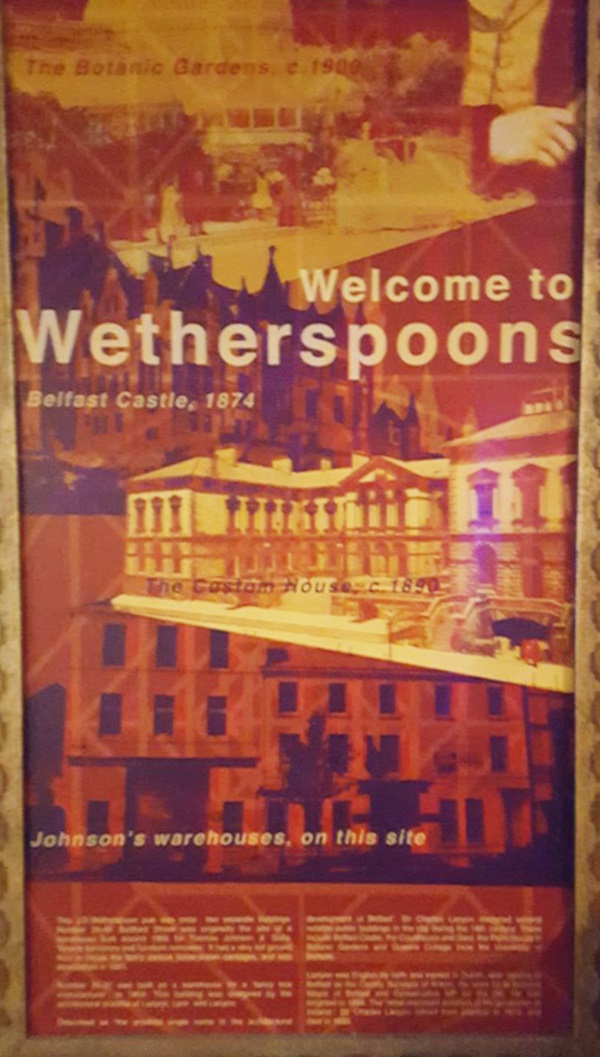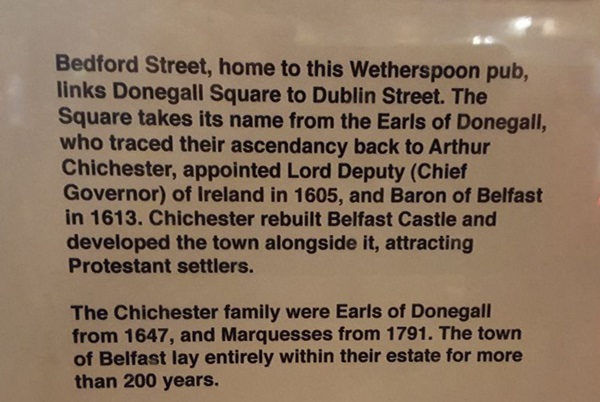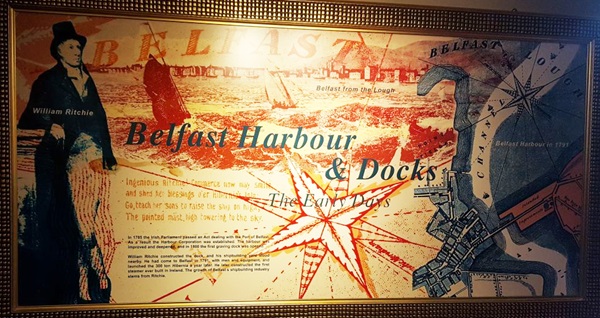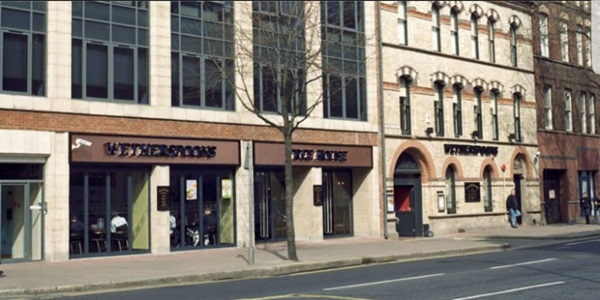The Old Dublin Bridge over the Blackstaff stood near these premises. The bridge was demolished when the river was channelled underground in the late 19th century. The oldest part of these premises was built, in 1868, for a fancy box manufacturer and designed by the eminent architect Sir Charles Lanyon. The adjoining part stands on the site of two warehouses, built around the same time for a furniture-removing and undertaking business.
Prints and text about this site.

The text reads: This J D Wetherspoon pub was once two separate buildings. Number 39-45 Bedford Street was originally the site of a warehouse built around 1865 for Thomas Johnson & Sons, ‘funeral furnishers and furniture removers’. It had a very tall ground floor to house the firm’s various horse-drawn carriages, and was demolish in 1991.
Number 35-37 was built as a warehouse for a ‘fancy box manufacturer’, in 1868. This building was designed by the architectural practice of Lanyon, Lynn and Lanyon.
Described as “the greatest single name in the architectural development of Belfast”, Sir Charles Lanyon designed several notable public buildings in the city during the 19th century. These include Belfast Castle, the Courthouse and Gaol, the Palm House in Botanic Gardens and Queens College (now the University of Belfast).
Lanyon was English by birth and trained in Dublin, later moving to Belfast as the Country Surveyor of Antrim. He went on to become mayor of Belfast and Conservative MP for the city. He was knighted in 1868. The “most important architect of his generation in Ireland”, Sir Charles Lanyon retired from practice in 1872, and died in 1889.
Text about Arthur Chichester.

The text reads: Bedford Street, home to this Wetherspoon pub, links Donegall Square to Dublin Street. The Square takes its name from the Earls of Donegall, who traced their ascendancy back to Arthur Chichester, appointed Lord Deputy (Chief Governor) of Ireland in 1605, and Baron of Belfast in 1613. Chichester rebuilt Belfast Castle and developed the town alongside it, attracting Protestant settlers.
The Chichester family were Earls of Donegall from 1647, and Marquesses from 1791. The town of Belfast lay entirely within their estate for more than 200 years.
Prints and text about Belfast harbour and docks.

The text reads: In 1785 the Irish Parliament passed an Act dealing with the Port of Belfast. As a result the Harbour Corporation was established. The harbour was improved and deepened, and in 1800 the first graving dock was opened.
William Ritchie constructed the dock, and his shipbuilding yard stood nearby. He had come to Belfast in 1791, with men and equipment, and launched the 300 ton Hibernia a year later. He later constructed the first steamer ever built in Ireland. The growth of Belfast’s shipbuilding industry stems from Ritchie.
An illustration, photographs and text about entertainment in Belfast.

The text reads: The Ulster Hall, (right), further along Bedford Street from this Wetherspoon pub, was one of the largest music halls in the British Isles when it opened in 1862. It remained the city’s main concert hall until 1997, when the new Waterfront venue opened.
The Grand Opera House in Great Victoria Street, (below left) is just a short walk from this pub. This famous architectural extravaganza, with its lavish interior, opened in 1895. In contrast, the Theatre Royal, (top right), which opened in Arthur Street in 1871, quickly became known as much for its dinginess and ‘odour of mingled oranges and escaped gas’ as for its performances. It was destroyed by fire ten years later, and by 1915 had become a cinema.
The Royal Hippodrome, (bottom right), stood next to the Grand Opera House in Great Victoria Street. Opened in 1907 it offered theatrical performances and silent movies. It switched to films only in 1931, becoming in turn the Odeon, then the New Vic, before it was demolished in the 1990s.
External photograph of the building – main entrance.

If you have information on the history of this pub, then we’d like you to share it with us. Please e-mail all information to: pubhistories@jdwetherspoon.co.uk